Topic 4- Partnerships – Book Keeping Form 4
The Basic Characteristics of a Partnership
Definition:
Another person who is a good manager but may not have capital. When these persons come together, pool their capital and skills and organise a business, it is called partnership. Partnership grows essentially because of the limitations or disadvantages of proprietorship.
More Persons:
As against proprietorship, there should be at least two persons subject to a maximum of ten persons for banking business and twenty for non-banking business to form a partnership firm.
Profit and Loss Sharing: There is an agreement among the partners to share the profits earned and losses incurred in partnership business.
Contractual Relationship: Partnership is formed by an agreement-oral or written-among the partners.
Existence of Lawful Business:
Partnership is formed to carry on some lawful business and share its profits or losses. If the purpose is to carry some charitable works, for example, it is not regarded as partnership.
Utmost Good Faith and Honesty: A partnership business solely rests on utmost good faith and trust among the partners.
Unlimited Liability:
Like proprietorship, each partner has unlimited liability in the firm.
This means that if the assets of the partnership firm fall short to meet the firm’s obligations, the partners’ private assets will also be used for the purpose.
Restrictions on Transfer of Share: No partner can transfer his share to any outside person without seeking the consent of all other partners.
Principal-Agent Relationship:
The partnership firm may be carried on by all partners or any of them acting for all. While dealing with firm’s transactions, each partner is entitled to represent the firm and other partners. In this way, a partner is an agent of the firm and of the other partners.
The Importance of Mutual Agency and Unlimited Liability to a Person about to become a Partner
Explain the importance of mutual agency and unlimited liability to a person about to become a partner
Advantages:
Easy Formation:
Partnership is a contractual agreement between the partners to run an enterprise. Hence, it is relatively ease to form. Legal formalities associated with formation are minimal. Though, the registration of a partnership is desirable, but not obligatory.
More Capital Available:
We have just seen that sole proprietorship suffers from the limitation of limited funds. Partnership overcomes this problem, to a great extent, because now there are more than one person who provide funds to the enterprise. It also increases the borrowing capacity of the firm.
Moreover, the lending institutions also perceive less risk in granting credit to a partnership than to a proprietorship because the risk of loss is spread over a number of partners rather than only one.
Combined Talent, Judgement and Skill:
As there are more than one owners in partnership, all the partners are involved in decision making. Usually, partners are pooled from different specialised areas to complement each other. For example, if there are three partners, one partner might be a specialist in production, another in finance and the third in marketing. This gives the firm an advantage of collective expertise for taking better decisions. Thus, the old maxim of “two heads being better than one” aptly applies to partnership.
Diffusion of Risk:
You have just seen that the entire losses are borne by the sole proprietor only but in case of partnership, the losses of the firm are shared by all the partners as per their agreed profit-sharing ratios.
Thus, the share of loss in case of each partner will be less than that in case of proprietorship.
Flexibility: Like
proprietorship, the partnership business is also flexible. The partners can easily appreciate and quickly react to the changing conditions. No giant business organisation can stifle so quick and creative responses to new opportunities.
Tax Advantage: Taxation rates applicable to partnership are lower than proprietorship and company forms of business ownership.
Disadvantages:
Descriptions of these drawbacks/ disadvantages are as follows:
Unlimited Liability:
In partnership firm, the liability of partners is unlimited. Just as in
proprietorship, the partners’ personal assets may be at risk if the
business cannot pay its debts.
Divided Authority:
Sometimes the earlier stated maxim of two heads better than one may
turn into “too many cooks spoil the broth.” Each partner can discharge
his responsibilities in his concerned individual area. But, in case of
areas like policy formulation for the whole enterprise, there are
chances for conflicts between the partners. Disagreements between the
partners over enterprise matters have destroyed many a partnership.
Lack of Continuity:
Death or withdrawal of one partner causes the partnership to come to an
end. So, there remains uncertainty in continuity of partnership.
Risk of Implied Authority:
Each partner is an agent for the partnership business. Hence, the
decisions made by him bind all the partners. At times, an incompetent
partner may lend the firm into difficulties by taking wrong decisions.
Risk involved in decisions taken by one partner is to be borne by other
partners also. Choosing a business partner is, therefore, much like
choosing a marriage mate life partner.
Difference between an Ordinary Partnership and Limited Partnership
Distinguish between an ordinary partnership and limited partnership
partnership (also referred to as a general partnership) is a business
arrangement where two or more people (who are not husband and wife) are
owners of a business. Unlike a corporation, you do not need to file any
documents with the state to make your business a partnership. A
partnership is created by default, unless the business is specifically
formed as some other type of business entity, such as a corporation, a
limited liability company, or a limited partnership.
general partnership is one in which all of the partners have the
ability to actively manage or control the business. This means that
every owner has authority to make decisions about how the business is
run as well as the authority to make legally binding decisions. Unless
the partners have a partnership agreement, each partner will have equal
authority.
in a general partnership don’t have any limit on their personal
responsibility for the debts of the business. This means that the
partner could lose more than just his investment in the business –
personal assets would have to be used to pay business debts if
necessary. Each partner in a general partnership is also “jointly and
severably” liable for debts of the business. Joint and severable
liability means is that each partner is equally liable for the debts of
the business, but each is also totally liable. So if a creditor can’t
get what he is owed by one or more of the partners, he can collect it
from another partner, even if that partner has already paid his share of
the total debt. If someone sues your partnership and obtains a large
judgment, and your partner doesn’t have the money to pay his share of
it, you will have to pay the entire amount.
limited partnership is different from a general partnership in that it
requires a partnership agreement. Some information about the business
and the partners must be filed with the appropriate state agency
(usually the secretary of state).
a limited partnership has both limited and general partners. A limited
partner is one who does not have total responsibility for the debts of
the partnership. The most a limited partner can lose is his investment
in the business. The trade off for this limited liability is a lack of
management control: A limited partner does not have the authority to run
the business. He is really more or less an investor in the business.
limited partnership must have at least one general partner. The general
partner or partners are responsible for running the business. They have
control over the day-to-day management of the business and have the
authority to make legally binding business decisions. The partnership
agreement will specify exactly which partner or partners have certain
responsibilities and which have certain authority. General partners are
also subject to unlimited personal liability for the debts of the
business. The general partners of a limited partnership are also jointly
and severably liable for the debts of the business, just like partners
in a general partnership. If you need a business type that limits the
liability of all partners.
agreement (also known as the partnership deed) is the agreement between
the partners. It is ideally in written form and it documents the rights
and responsibilities of the partners and addresses other matters to
which the partners agree at the time of partnership formation.
partners have to satisfy the relevant state’s legal requirements
related to formation of partnerships, obtain tax number for the
business, obtain any required licenses (such in public accounting, etc.)
and agree on the terms of the partnership with each other.
of a partnership involves investment by the partners in the partnership
either in the form of cash or in the form of assets. When partners
introduce cash or any other asset, cash or the other asset account is
debited at the value agreed by the partners and the corresponding
partner’s capital account is credited by the same amount.
Example 1
Consultancy is a partnership established by Jazz and Indigo. The
business is engaged in providing consultancy to telecommunication
companies on revenue assurance. On 1 January 20X2, Jazz contributed
contribute cash of $300,000 while Indigo introduced a vehicle with a
written down value of $40,000 and fair value of $80,000, paid 2 years
prepaid rent for office building of $70,000 and introduced technical
equipment of $60,000 and marketable securities of $100,000. A firm of
Indigo’s friend did the furnishing work for $70,000 and JI Consulting
agreed to pay off the loan in the first week of the partnership’s
formation. Journalize the formation of the partnership.
The
formation of partnership would involve recording the assets on the
partners’ balance sheet and creating corresponding capital accounts by
the following journal entry:
| DR | CR | |
| Cash | 300,000 | |
| Marketable securities | 100,000 | |
| Prepaid | 70,000 | |
| Furniture and fittings | 70,000 | |
| Vehicles | 80,000 | |
| Equipment | 60,000 | |
| Sales | 70,000 | |
| Sales | 300,000 | |
| Sales | 310,000 |
B and C are partners in a partnership firm with capital A- Rs.5,00,000;
B- Rs.7,00,000 and C- Rs4,00,000. During the year 2012, the firm earned
a net profit of Rs. 2,00,000. The partners are to entitled to an
interest on capital @ 6% p.a. They also made some drawings on which
interest to be charged is A-Rs.400; B-Rs 500 and C- Rs250. A is entitled
to Rs.2000 p.m. as salary. B is to get 5% of the net profit after all
adjustments as commission. Also 10% of the profits remaining before
providing commission to B is to be transferred to General Reserve.
Profit are shared among A, B and C in the ratio 1:1:2 respectively.
Prepare Profit and Loss Appropriation account to show the above
adjustments.
| Particulars | Amount(Rs) | Particulars | Amount(Rs) |
| To Interest on Capital: | By Net Profit | 2,00,000 | |
| A-Rs. 30,000 | By Interest On Drawings | ||
| B-Rs. 42,000 | A- 400 | ||
| C-Rs.24,000 | 96,000 | B- 500 | |
| To Salary (A) | 24,000 | C-250 | 1,150 |
| To General Reserve | 8,115 | ||
| To Commission (B) | 7,303 | ||
| To Profit transferred to: | |||
| A-16,433 | |||
| B-16,433 | |||
| C-32,866 | 65,732 | ||
| 2,01,150 | 2,01,150 |
Earnings to Partners: On a Sated Fractional Basis; In the Partners
Capital Ratio and through the Use of Salary and Interest Allowances
partnership earnings to partners: On a stated fractional basis; In the
partners capital ratio and through the use of salary and interest
allowances
partnership earnings to partners: On a stated fractional basis; In the
partners capital ratio and through the use of salary and interest
allowances
upon the share of profits to be given to the new partner, either a sum
of money will be directly paid by him to the old partners (through the
firm or privately) or after recording new partner’s capital, new
partner’s capital account will be debited with his share of goodwill,
the credit being given to the old partners in the ratio of their
sacrifice of future profits. The latter is an indirect method of payment
for goodwill by the new partner. The payment is justified became the
new partner will take a share of profits which comes out of the shares
of other partners. The old partners must be compensated for such a loss.
- The new partner brings goodwill in cash which is left in the business.
- The new partner brings goodwill in cash but the cash is withdrawn by the old partners.
- The amount of goodwill is paid by the new partner to the old partners privately.
- The
new partner does not bring in cash for goodwill as such; but an
adjustment entry is passed by which the new partner’s capital account is
debited with his share of goodwill and the amount is credited to old
partners’ capital accounts in the ratio of sacrifice. This entry reduces
the capital of the new partner by the amount of his share of goodwill
and results in payment for goodwill by the new partner to the old
partners.
considering the entries to be made in the above cases, one must decide
regarding the ratio in which goodwill is to be credited to the old
partners. Traditionally, goodwill was credited to the old partners in
the old profit-sharing ratio and, if the amount was to be written off as
in case (v) above, it was written off to all the partners in the new
profit-sharing ratio.
would be no doubt that this should be the case when, on the admission
of a new person as partner, the ratio as among the old partners does not
change. But what if on the admission of a new partner, the
profit-sharing ratio of old partners as among themselves is also
changed.
one treats paying sums in respect of goodwill to old partners as
compensation for their surrendering to the new partner a part of their
profits, then obviously the amount to be credited to partners should be
in then ratio of loss of profits. Suppose, A and B, sharing in the ratio
of 3: 2, admit C as partner and it is agreed that the new
profit-sharing ratio is 2: 2: 1. It is obvious that B does not suffer at
all on Cs admission. He previously received 2/5ths of profits; he still
receives 2/5ths of profits. It is A alone who has suffered and,
therefore, any amount brought in as goodwill by C should be credited to
only A. Thus, it is proper to credit goodwill brought in by a new
partner to the old partners in the ratio in which they suffer on the
admission of the new partner.

and B share profits in the ratio: A, 5/8 and B 3/8. C is admitted as
partner. He brings in Rs 70,000 as his capital and Rs 48,000 as
goodwill. The new profit-sharing ratio among A, B and C respectively is
agreed to be 7: 5: 4 respectively. Pass Journal entries.
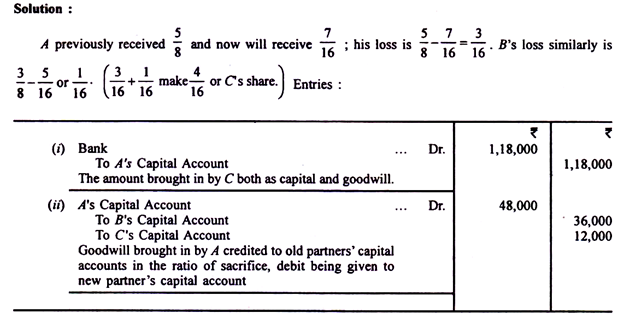
the above illustration, the old partners have allowed the amounts of
goodwill credited to their capital accounts remain in the business.
However, the arrangement may allow the old partners to wholly or partly
withdraw the amounts of goodwill credited to their capital accounts.
Suppose, in the above illustration, A and B withdraw their shares of
goodwill A and B withdraw their shares of goodwill brought in by C.

the case is that the amount of goodwill is paid by the new partner to
the old partners privately, no entry is passed in the books of the firm.
But the calculations have to be made in the same manner as shown above.
and B are partners sharing profits and losses in the ratio 3:2
respectively. They admit C as partner who is unable to bring goodwill in
cash but pays Rs 96,000 as his capital. The goodwill of the firm is to
be valued at two years’ purchase of three years’ profits. The profits
for the three years were Rs 30,000, Rs 24,000 and Rs 27,000. An
adjustment entry is to be passed for C’s share of goodwill. The new
ratio will be 5: 2: 2. Pass journal entries.
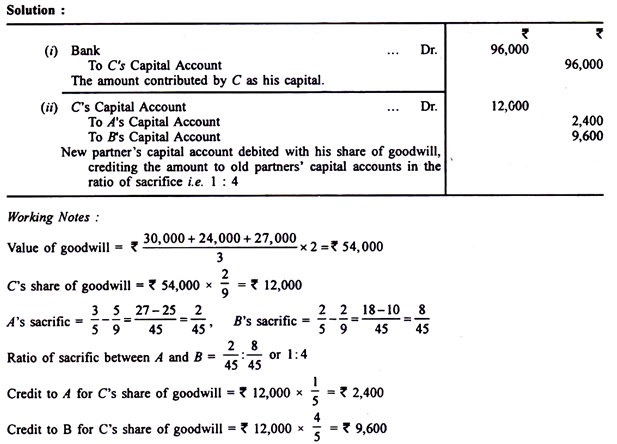
and Y were partners sharing profits in the ratio of 5:4 respectively.
On 1st April, 2012 they admitted Z as a new partner; all the partners
agreeing to share future profits equally. On the date of admission of
the new partner, there was a goodwill account in the old firm’s ledger
showing a balance of Rs 18,000. The current value of firm’s goodwill was
placed at Rs 36,000. Z paid Rs 50,000 by way of his capital. He also
paid an appropriate amount for his share of goodwill. X and Y wrote off
the goodwill account before Z’s admission.
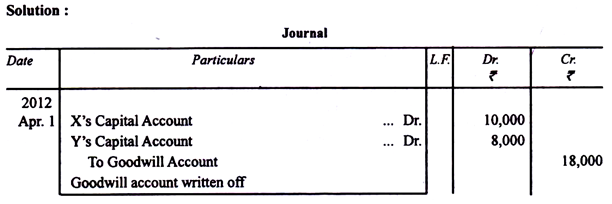
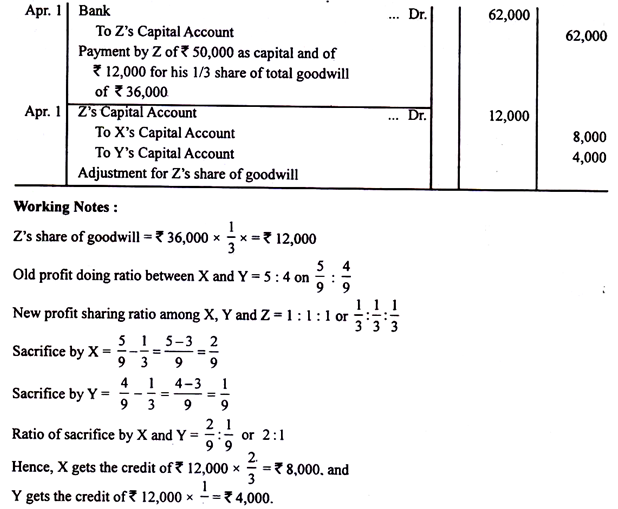
a new partner is admitted, it is natural that he should not benefit
from any appreciation in the value of assets which has occurred (nor
should he suffer because of any fall which has occurred up to the date
of admission) in the value of assets. Similarly, for liabilities.
assets and liabilities are revalued and the old partners are debited or
credited with the net loss or profit, as the case may be, in the ratio
in which they have been sharing profits and losses hitherto. Partners
may agree that the change in the value of assets and liabilities is to
be adopted and figures changed accordingly or that the assets and
liabilities should continue to appear in the books of the firm at the
old figures.
- Values
to be altered in books. In this case, a Profit and Loss Adjustment
Account (or Revaluation Account) is opened and the following steps
should be taken
If the values of assets increase, the particular assets should be
debited and the Revaluation Account credited with the increases only.
If the values of assets fall, the Revaluation Account should be debited
and the particular assets credited with the fall in values.
the value of debtors, investments or stock falls, the entry should be
to debit the Revaluation Account and credit a suitable provision
account. Thus, suppose it is desired to record a fall in value of
investments to the extent of Rs 9,500.
The entry is:

there is already a provision against a particular asset and the value
of that asset increases, the entry should be to debit the Provision and
credit Revaluation Account rather than to follow (a) above.

Any reduction in the amounts of liabilities is a profit and hence the
liabilities accounts should be debited and Revaluation Account credited
with the difference between the old and present figures.
The Revaluation Account should then be closed by transfer to old
partners’ capital (or current) accounts in the old profit-sharing ratio.
If debits exceed the credits, it is a loss and the entry is to debit
partners’ capital (or current) accounts and credit Revaluation Account.
Reverse entry is made when the credits exceed debits.

- That C pays Rs 40,000 as his capital for a fifth share.
- That C pays Rs 20,000 for goodwill. Half of this sum is to be withdrawn by A and B.
- That
Stock and Fixtures be reduced by 10% and a Provision for Doubtful Debts
amounting Rs 950 be created on Sundry Debtors and Bills Receivable. - That the value of Land and Buildings be appreciated by 20%.
- There being a claim against the firm of damage, a liability to the extent of Rs 1,000 should be created.
- An item of Rs 650 included in Sundry Creditors is not likely to be claimed and hence should be written off.
journal entries for the above-mentioned transactions excluding cash
transactions; prepare cash book and important ledger accounts. Also
prepare the balance sheet of the firm immediately after Cs admission.
Assume the profit-sharing ratio as between A and B has not changed.
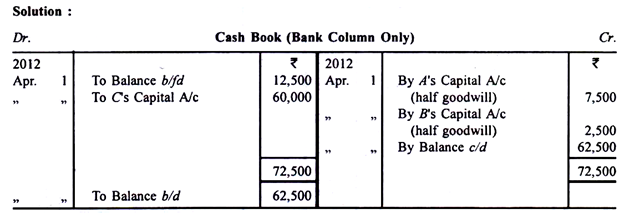
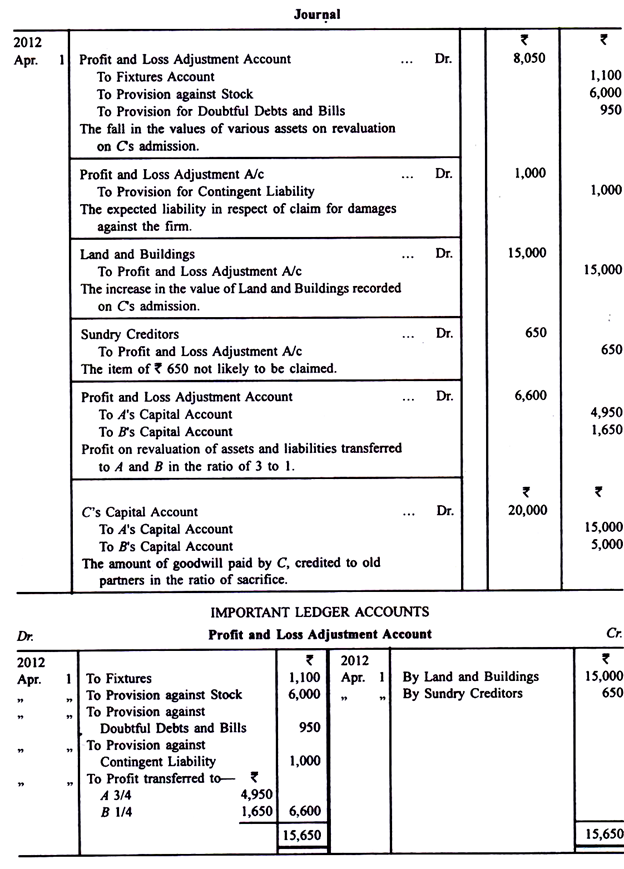
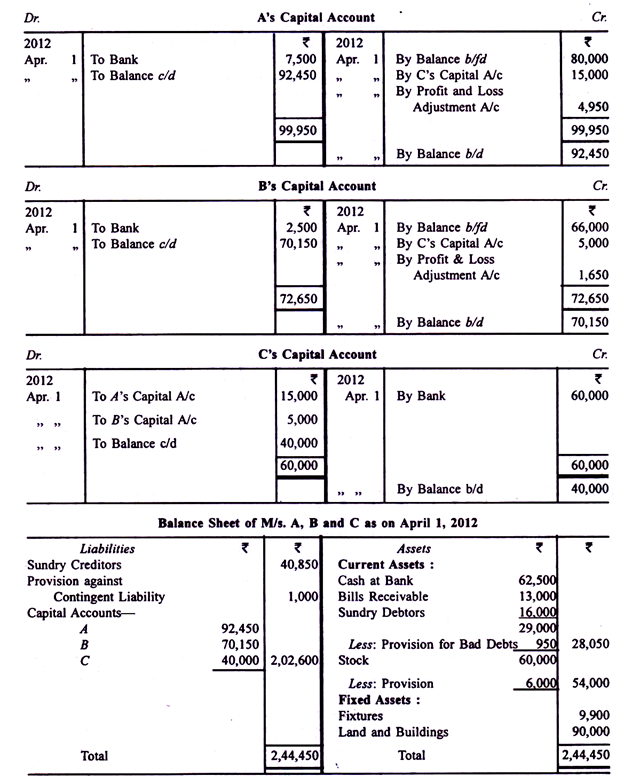
When values are not to be altered. In this case, the increases and
decreases in the values of assets and liabilities are entered in a
Memorandum Revaluation Account without passing corresponding entries in
the assets and liability accounts. The balance is transferred to old
partners’ capital accounts in the old profit-sharing ratio. Then,
entries passed in Memorandum Revaluation Account for increases and
decreases in the values of assets and liabilities are reversed, again
without passing any entry in the assets and liability accounts. The
balance of Memorandum Revaluation Account is, this time, transferred to
all partners (including the new one) in the new profit-sharing ratio.
the illustration above, the Memorandum Revaluation Account and the
capital accounts will appear as follows if this method is to be
followed:
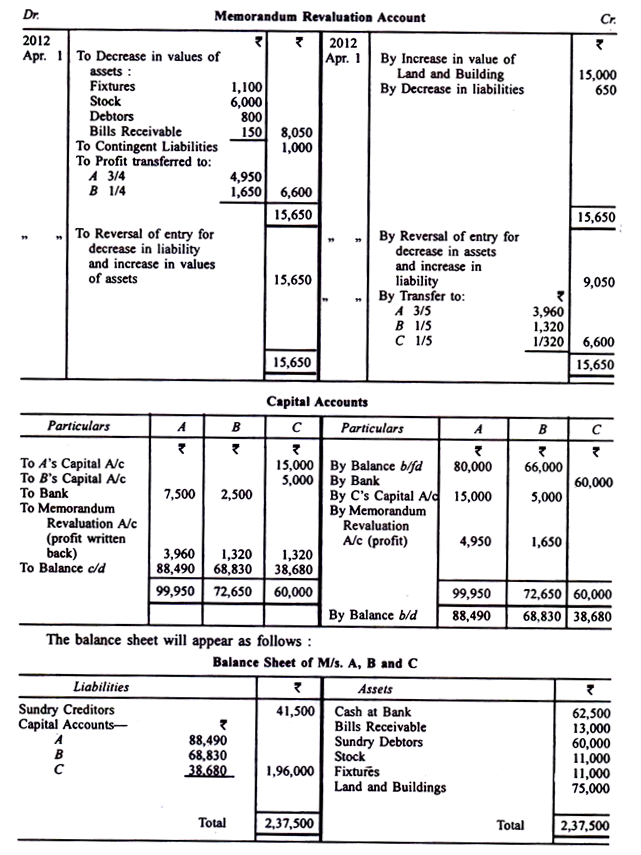
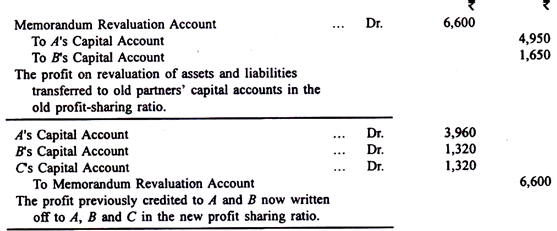
out the new profit-sharing ratio might involve a little calculation.
The language of the agreement is the most important factor. In some
cases, the new ratio is given. In others, only the share to be given to
the new partner is given; the assumption is that as amongst the old
partners, the ratio does not change. In such a case, one should deduct
from 1 the share of the new partner and then divide the remainder among
the old partners in the old ratio. Suppose, A and B are partners sharing
profits and losses in the ratio of 5: 3 respectively. They admit C and
agree to give him 3/10 of the profits.
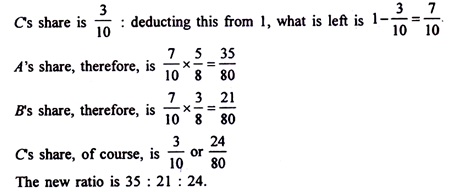
certain cases, the incoming partner “purchases” his share from the
other partners in different proportions. Suppose, A and B sharing
profits in the ratio of 5: 3 respectively admit C giving him a 3/10
share of profits of the firm. If C acquires 4/20 share from A and 2/20
share from B, the new ratio will be
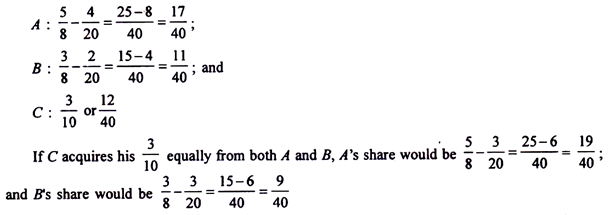
Glucose and Cibazol have a practice producing Rs 3,72,900 per annum,
which they divide in proportions of 17/33 and 16/33. They admit Dr.
Zambuck to partnership on the basis of his buying, at 2 years’ purchase,
5/17 of Dr. Glucose’s share and 4/16 of Dr. Cibazol’s share. After the
lapse of three years, they permit Dr. Zambuck to purchase a further 1/12
of their remaining shares. How much did Dr. Zambuck pay to each of the
others on each occasion, and what is the ultimate share of each partner
in the practice?
first, Dr. Zambuck buys 5/17 of Dr. Glucose’s share. That comes to
(5/17) x (17/33) or 5/33 Dr. Glucose’s share, therefore, is
(17/33)-(5/33) or 12/33. Dr. Zambuck acquires (4/16)x (16/33) or 4/33
from Dr. Cibazol whose share, therefore, is (16/33)-(4/33) = 12/33.
Total share of Dr. Zambuck is [(5/33) + (4/33)] or 9/33. Goodwill is
valued at Rs 3,72,900 x 2 or Rs 7,45,800. Therefore, Dr.Zambuck has to
pay Rs 7,45,800 x 9/33 or Rs 2,03,400 which is shared by Dr. Glucose and
Cibazol in the ratio of 5 : 4 (the ratio in which they lose profits).
Rs 1, 13,000 will go to Dr. Glucose and Rs 90,400 to Dr. Cibazol. The
new ratio is 12/33,12/33 and 9/33. Later, Dr. Zambuck acquires 1/12 of
each partner’s share. Hence, he acquires 12/33 x 1/12 or 1/33 from both
the other partners. The share of Dr. Glucose is reduced to 12/33-1/33 or
11/33. So also for Dr. Cibazol. The share of Dr. Zambuck comes to be
9/33 + 1/33 + 1/33 = 11/33. Hence, all partners are now equal. Dr.
Zambuck will have to pay 7,45,800 x 1/33 or ? 22,600 to each of the
other two partners by way of goodwill.
existing at the time of the admission of a new partner should always be
transferred to the capital or current accounts of the old partners in
the profit-sharing ratio. Students should remember to do this even if
the question is silent on the point.
is often agreed on admission of a partner that the capitals of all
partners should be in proportion to their respective shares in profits.
The starting point may be the new partner’s capital or the new partner
himself may be required to bring in capital equal to his share in the
firm. If the new partner’s capital is given, one should find out the
total capital of the firm on the basis of his share.
the capital required of other partners should be ascertained. Suppose, C
is admitted in a firm with a 1/4 share of the profits of the firm. C
contributes Rs 15,000 as his capital, A and B, the other two partners,
were sharing profits in the ratio of 3: 2.
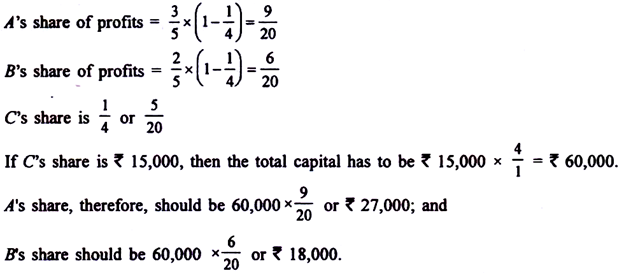
is similar if the basis is the existing partners’ capitals and the new
partner is required to bring in proportionate capital. Suppose, after
making all adjustments as regards goodwill and revaluation of assets,
etc., the capitals of A and B are ?20,000 and Rs 16,000. The profits and
losses are shared by A and B in the ratio of 5: 3 respectively. C is
admitted and is to be given 1/4th share of profits. He has to bring in
capital representing his share. C gets 1/4, 3/4 is left for A and B.
the combined capital of A and B, viz., Rs 36,000 represents 3/4 share.
Total capital should be 36,000 x4/3 or Rs 48,000. C should bring Rs
12,000, i.e., 48,000 x 1/4. In other words, C’s share is 1/3 of the
combined shares of A and B (1/4:3/4); his capital should be 1/3 of the
combined capitals of A and B.
the actual capital of a partner is more than his proportionate share,
the difference should be credited to his current account. If the actual
is less, he should being in the requisite amount of cash or else his
current account should be debited. If the Partnership Deed requires
capitals to be proportionate to the profit-sharing ratio, the capitals
should be treated as fixed.
following was the Balance Sheet of A, B and C sharing profits and
losses in the proportion of 6/14, 5/14 and 3/14 respectively:

- (1) That D brings in Rs 48,000 as his capital.
- That furniture be written down by Rs 2,760 and stock be depreciated by 10%.
- That provision of Rs 3,960 be made for outstanding repair bills.
- That the value of land and buildings be written up to Rs 1,95,300.
- That the value of goodwill be fixed at Rs 28,000 and an adjustment entry be passed for D’s share of goodwill.
- That the capitals of A, B and C be adjusted on the basis of D’s capital by opening current accounts.
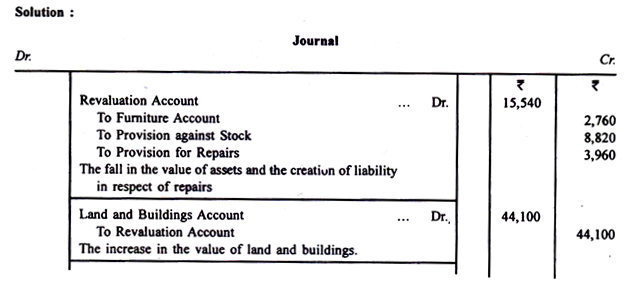
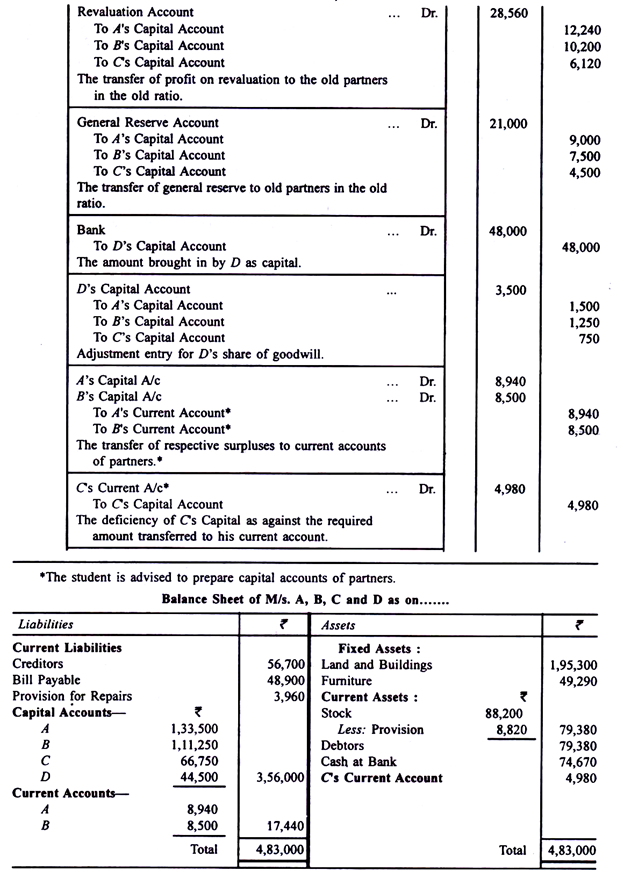
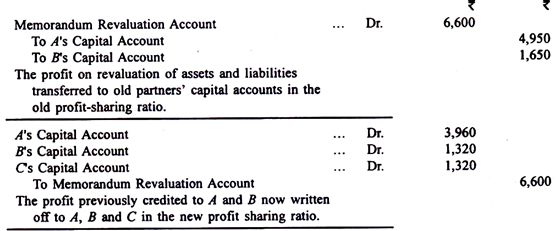
balance sheet of a partnership firm of X and Y, who were sharing
profits in the ratio of 5: 3 respectively, as on 31st March, 2012 was as
follows:

- Z would get 1/5th share in the profits.
- Z would pay Rs 1, 20,000 as capital and Rs 16,000 for his share of goodwill.
- Machinery
would be depreciated by 10% and building would to be appreciated by
30%. A provision for bad debts @ 5% on debtors would be created. An
unrecorded liability amounting to Rs 3,000 for repairs to building would
be recorded in the books of account. - Immediately after Z’s
admission, goodwill account would be written off. Thereafter, the
capital accounts of the old partners would be adjusted through the
necessary current accounts in such a manner that the capital accounts of
all the partners would be in their profit showing ratio. Prepare
revaluation account, capital accounts and the initial balance sheet of
the new firm.
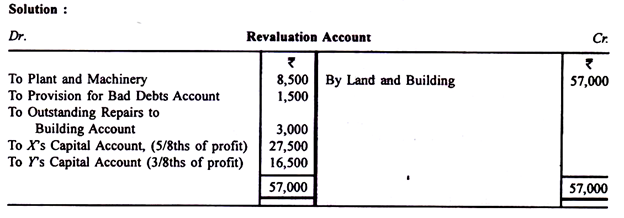
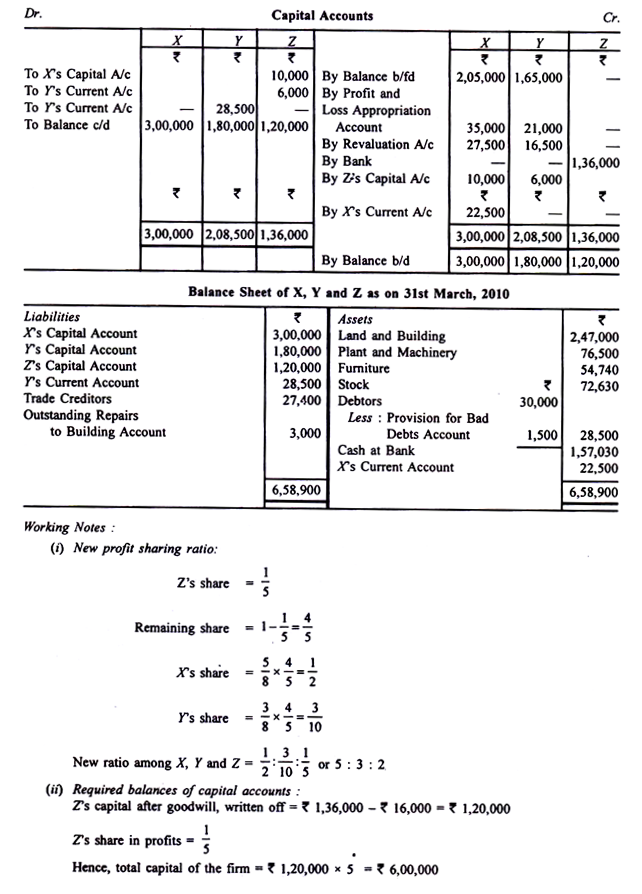
PARTNERSHIPS





